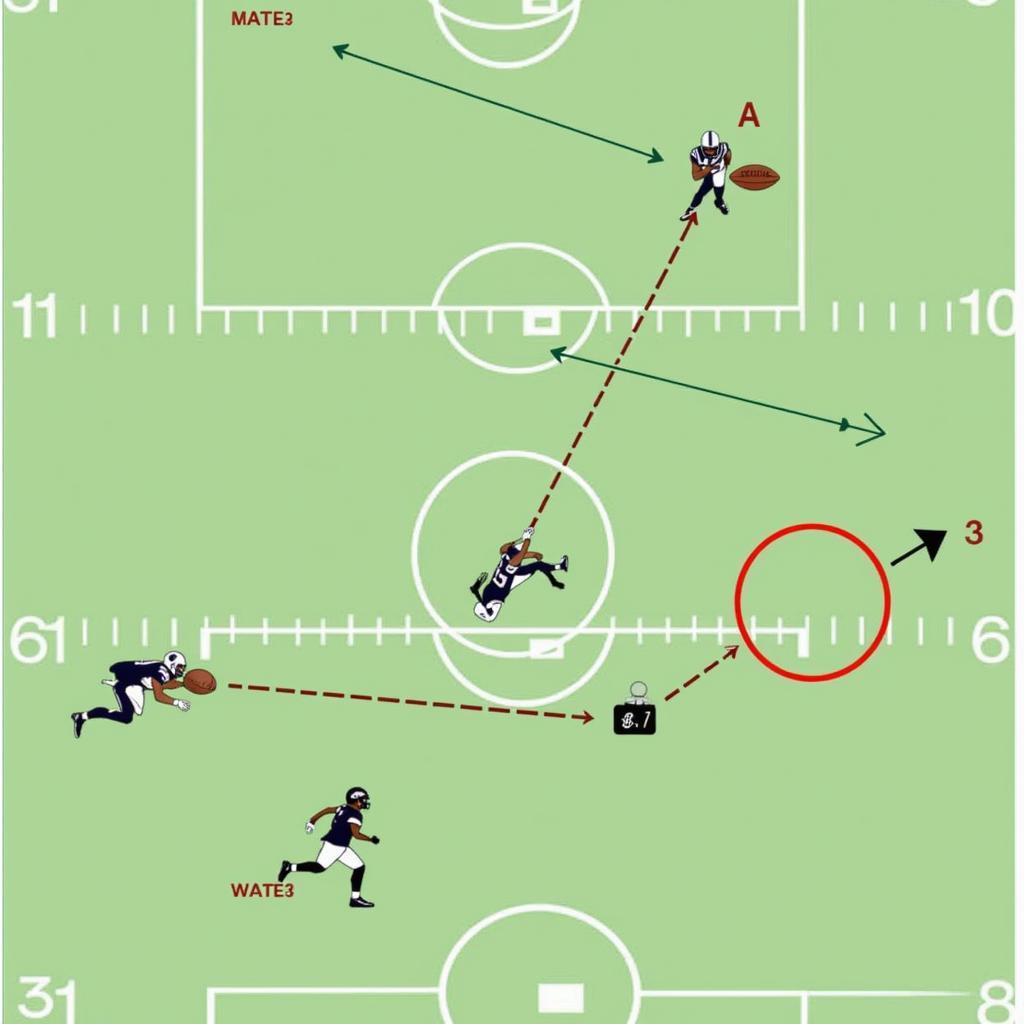Running Back Routes are a critical component of any successful offense. Understanding how to utilize these routes effectively can significantly impact your team’s ability to gain yards and score touchdowns. This guide will delve into the intricacies of running back routes, covering everything from basic concepts to advanced strategies.
Effective route running by running backs requires a blend of speed, agility, and precise execution. It’s not just about getting open, but also about setting up blocks and creating opportunities for other players on the field. After understanding basic concepts, you can then learn to manipulate defenders and exploit weaknesses in the defense. Let’s dive in!
Understanding the Fundamentals of Running Back Routes
At the core of every running back route is a simple principle: create separation from the defender. This can be achieved through various techniques, including sharp cuts, changes of pace, and deceptive movements. Whether it’s a simple check-down or a complex wheel route, the goal remains the same: get open and make yourself available for the quarterback. Learning the basics of corner routes can be especially valuable for running backs looking to expand their route tree.
Basic Running Back Route Types
Several fundamental route types form the foundation of a running back’s route tree. These include:
- Flat Route: A short route run parallel to the line of scrimmage, often used as a safety valve for the quarterback.
- Swing Route: Similar to the flat route but run with a slight arc towards the sideline.
- Angle Route: A route run diagonally towards the sideline, aiming to exploit the space between the linebacker and the cornerback.
- Texas Route: A quick, short route designed to get the running back the ball in space quickly.
- Wheel Route: A deep route where the running back starts towards the line of scrimmage and then turns upfield, often catching defenders off guard.
Advanced Running Back Route Concepts
Once you’ve mastered the basics, it’s time to explore more advanced running back routes and techniques. These routes often involve more intricate movements and require a deeper understanding of defensive schemes. Knowing what routes beat cover 2 and what routes beat cover 3 can significantly enhance a running back’s effectiveness in exploiting defensive vulnerabilities.
Reading the Defense
A key element of advanced route running is the ability to read the defense. By observing the positioning and movements of the defenders, running backs can adjust their routes accordingly to create separation and get open. This involves recognizing coverage schemes, anticipating blitzes, and understanding how to manipulate defenders with subtle movements.
Utilizing Route Combinations
Combining different routes can create confusion for the defense and open up opportunities for big plays. For example, a running back running a wheel route can draw the safety deep, leaving space underneath for a tight end running a drag route. Understanding football split back formation plays can also be beneficial when looking to diversify your team’s offensive strategy.
 Running Back Wheel Route Against Cover 3
Running Back Wheel Route Against Cover 3
Training and Practice for Running Back Routes
Improving your route running skills requires dedicated training and practice. Focus on developing your footwork, agility, and speed. Regular drills and repetitions will help you refine your technique and build muscle memory.
Drills for Improved Route Running
- Cone Drills: Enhance agility and footwork by weaving through cones.
- Ladder Drills: Improve speed and coordination.
- Route Tree Drills: Practice running different routes against simulated defenders.
“Consistent practice and attention to detail are essential for mastering running back routes,” says Coach John Smith, a renowned expert in offensive strategy with over 20 years of coaching experience. “Focus on developing your footwork and understanding the nuances of each route.”
Conclusion
Mastering running back routes is a continuous process that demands dedication, practice, and a deep understanding of the game. By focusing on the fundamentals, learning to read the defense, and incorporating advanced techniques, you can elevate your game and become a more versatile and effective player. Running back routes are an integral part of a successful offense, and by honing your skills in this area, you’ll significantly contribute to your team’s success. Remember, efficient route running by running backs can be the difference between a win and a loss.
FAQ
-
What is the easiest running back route to learn? The flat route is often considered the easiest due to its simplicity.
-
What are the most common running back routes in the NFL? Flat, swing, angle, and wheel routes are frequently used.
-
How can I improve my route running speed? Focus on improving your acceleration and top-end speed through sprint training and agility drills.
-
How do I read the defense when running a route? Pay attention to the positioning and movement of linebackers and safeties.
-
What makes a good running back route runner? A combination of speed, agility, precise footwork, and the ability to read the defense.
-
How can I avoid dropping passes on running back routes? Practice catching the ball in different situations and focus on hand-eye coordination.
-
What’s the best way to practice running back routes? Utilize cone drills, ladder drills, and route tree drills against simulated defenders.
Considering these scenarios can enhance your running back route performance.
- Scenario 1: Facing a blitz – Quickly identify the blitzing defender and adjust your route to create an open passing lane for the quarterback.
- Scenario 2: Man-to-man coverage – Utilize sharp cuts and changes of pace to create separation from your defender.
- Scenario 3: Zone coverage – Find the soft spot in the zone and sit down in the open space.
Need more in-depth guides? Explore articles about the best pass coverage linebackers madden 24.
For any assistance, feel free to reach out to us. Contact Number: 0902476650, Email: [email protected] Or visit us at: 139 Đ. Võ Văn Kiệt, Hoà Long, Bà Rịa, Bà Rịa – Vũng Tàu, Việt Nam. We have a 24/7 customer support team.





